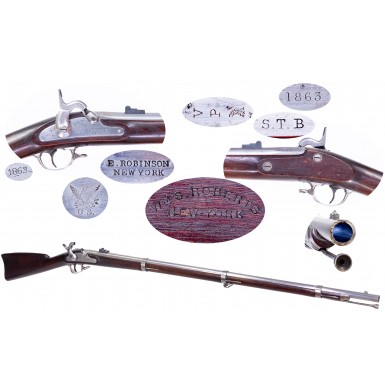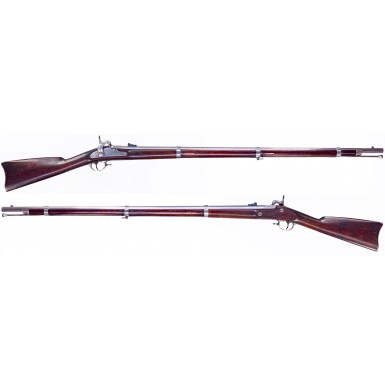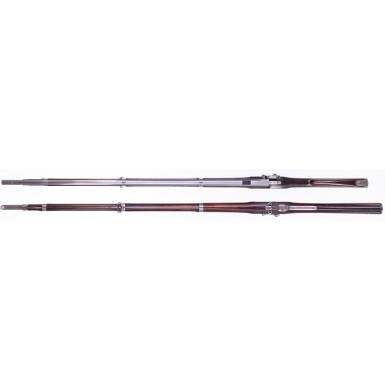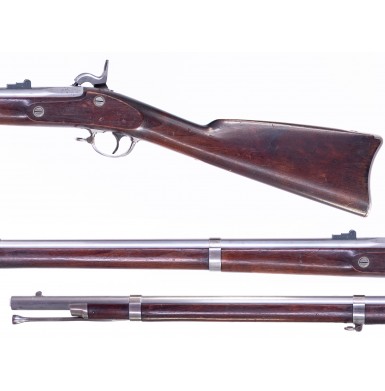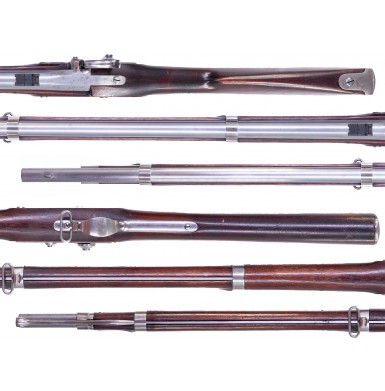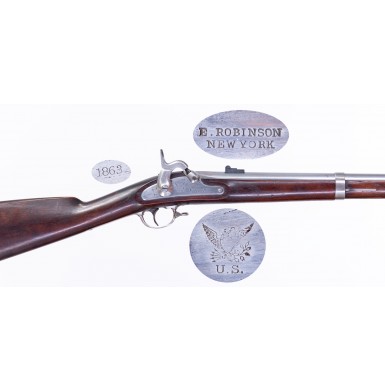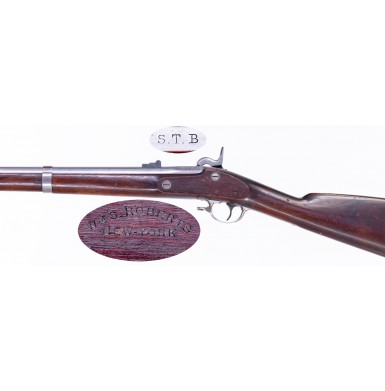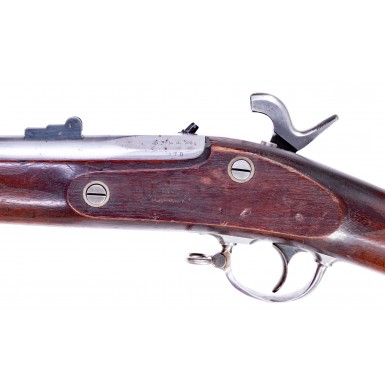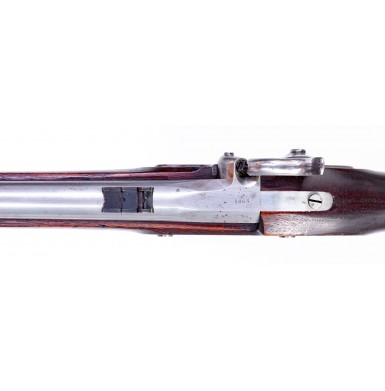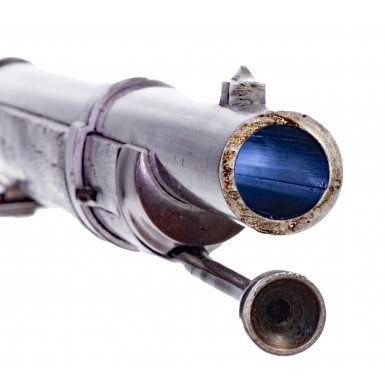Very Rare & Fine Marked in Wood Sarson & Roberts Contract US Model 1861 Rifle Musket by E Robinson
- Product Code: FLA-B211
- Availability: Out Of Stock
-
$3,750.00
The contract US Model 1861 Rifle Muskets delivered by the New York firm of Sarson & Roberts are among the rarest of US contract rifle muskets. Out of an original contract of 25,000 rifle muskets the firm delivered only 5,643 guns, which represents only .003% of the more than 1.5 million .58 US Model 1861/63/64 produced during the American Civil War.
The company was a partnership between John B. Sarson and William S. Roberts. On 3 August 1861 Sarson & Roberts received a contract to deliver 25,000 US Model 1861 rifle muskets at a contract price of $18.50 per stand of arms. Nearly a year later, on 17 June 1862, the contract was reduced to 20,000 stands of arms by the Holt-Owen Commission, which had been appointed in the spring of 1862 to review, audit and modify as they saw fit all incomplete Ordnance Department contracts which had previously been entered into. The commission also adjusted the contract price to $20.00 per stand for 1st quality arms, with reductions to be applied to any arm that did not pass inspection and gauging as being first quality weapons. At the time of the contract modification, Sarson & Roberts were yet to deliver any of the guns that had previously been contracted for. Testimony before the Holt-Owen Commission, as well as correspondence from the company itself to the Ordnance Department, paints a confusing and contradictory story about the manufacture of the arms.
According to the research presented by James Whisker, Daniel Hartzler & Larry Yantz, in their book The US Model 1861 Springfield Rifle Musket – 2nd Edition, Sarson & Roberts reported that as of February 8, 1862, they had purchased stock making machinery and stock blanks and were successfully producing stocks. The same report claimed that they installed lock making machinery, machinery to make rough barrels and that their initial barrels had been produced, were already proved and were in the process being of being finished. They also claimed to have procured a suitable supply of iron to produce barrels. Strangely the same correspondence indicated that the partners were having a difficult time procuring the necessary raw materials to manufacture the guns, and that they had seriously underestimated the costs involved in the getting the endeavor set up and operational. On 7 April 1862 the partners testified directly before the Holt-Owen commission and noted that their stock-making machine had been built by a Mr. Pusey and had been in operation at their factory for two months. During that time 200 stocks had been finished. If the partners could only produce 100 stocks a month, it was clearly unlikely they would successfully fulfill the terms of their contract and come anywhere near their contracted delivery schedule. Their original contract called for the delivery of 500 stands of arms each in July, August and September of 1862, 1,000 each in October and November of the same year, and 1,500 per month thereafter until the contract was completed. Interestingly, in the same testimony they mentioned that Pusey had a stocking shop, which may have alluded to obtaining finished stocks directly from Pusey in addition to producing them. They further testified that they had entered into an arrangement with Alfred Jenks & Sons to produce all of the necessary components to produce the rifle muskets, with the exception of the stock, barrel and sight. This is again an odd contradiction to their statement in February regarding the installation of lock making machinery. Even more contradictory testimony was provided by Jenks, who reported to the commission on 28 March of 1862 that,
“We are making all of the gun, except the barrel, for Sarson & Roberts for 25,000 (stands of arms)”.
Problems with production continued to plague Sarson & Roberts, and at the end of March of 1862, they requested assistance from the Ordnance Department to help with the proving of the barrels that they had on hand. For whatever reason, they received no response or assistance until the end of April 1862. Sarson & Roberts continued to have problems producing or obtaining barrels that were of sufficient quality to pass inspection and proving. The company apparently became desperate to acquire parts and approached Springfield Arsenal to obtain barrels, locks, and any other parts that they could purchase to assemble complete arms. This fact is borne out by the fact that the 1867 Ordnance Report (the famous “Document 99”) notes that $8,434.12 was deducted from the final payments to Sarson & Roberts for the parts that had been furnished to them by the US government.
Sarson & Roberts began delivering completed arms on November 22, 1862, supplying 143 1st class guns @ $20.00 each, 286 2nd class guns @ 19.90 each, 36 3rd class guns @ 18.00 each and 18 4th class guns @ $16.00 each. Deliveries continued through 20 November of 1863, with a total of 5,643 guns being accepted. Of those only 3,761 were classified as “1st Class” arms. The remaining guns delivered were classified as 2nd, 3rd and 4th class, much like the initial delivery was. Sarson & Roberts delivered a total of 983 arms in 1862, and the rest were delivered in 1863. The scarcest examples of the rare Sarson & Roberts contract guns are those that were assembled with a mixture of parts from Springfield Armory, as well as other sources. Those that were assembled with Springfield marked locks or those marked by other makers are marked on the flat, opposite the lock with a WM S. Roberts maker’s cartouche. To date, only handful of these examples that are marked in the wood are known to exist.
The Sarson & Roberts US Model 1861 Rifle Musket offered here is in about VERY FINE condition and is a scarce example of a gun that was marked in the wood opposite the lock to identify it as their work. Interestingly the gun is not inspected, suggesting that the gun was never accepted for service by the Ordnance Department. I have previously owned an example of one of these guns that was marked in the wood, but which utilized a Springfield Arsenal lock. It has been more than a decade since I have even seen one of these wood-marked Sarson & Roberts guns. At a minimum this example uses a lock from another New York based contractor, Edward Robinson, and may well have been completely assembled by Robinson. Interestingly Robinson had himself been involved in a failed attempt to deliver Model 1861 Rifle Muskets under contract, as he was involved with the Union Arms Company. Robinson reentered the arms contracting business in June of 1863 when he received a contract from the Ordnance Department for 20,000 US Model 1861 Rifle Muskets. Robinson’s partnership and principles in the firm included many of the men formerly involved with the insolvent Union Arms Company. Interestingly, on 5 November 1863 William S Roberts of Sarson & Roberts contracted with Robinson to provide 15,000 US Model 1861 Rifle Muskets. This was only five days before the final Sarson & Roberts official delivery of 1,000 Rifle Muskets to the US Government. This suggests that Roberts was looking for a way to fulfill the remaining terms of the Ordnance Department contract but was unable to produce the guns on his own. Thus, Roberts was looking to purchase completed arms to deliver. This could be one of those guns, as the stock bears the WM S. ROBERTS / NEW-YORK cartouche.
As noted, the lock is a Robinson produced lock and is clearly marked in two lines forward of the hammer, E. ROBINSON/NEW YORK and is dated 1863 at the tail. The usual {Spread-Winged American Eagle} is stamped on the lock as well. The breech of the barrel is stamped with the matching 1863 date. The left angled breech flat of the barrel is stamped with the usual V / P / {Eagle Head} proof marks and the left barrel flat is stamped with the sub-inspection initials S.T.P. this marking is what makes it unclear if the gun was entirely produced by Robinson and delivered to Sarson & Roberts or if this a Sarson & Roberts gun with a Robinson supplied lock. The initials are the mark of Springfield Arsenal civilian sub-inspector Samuel T Bugbee who inspected barrels at Sarson & Roberts during 1863. While Bugbee inspected a variety of contract arms, the only other maker of Model 1861 Rifle Muskets any of his marks are associated with are those of Bridesburg contract arms. Thus, the barrel is apparently a Sarson & Roberts barrel, or it was inspected by Bugbee after it was delivered to Sarson & Roberts by Robinson. The gun does not bear any inspection cartouches which suggest it was never accepted by the Ordnance Department. This could be because the Sarson & Roberts operation never made another delivery after 20 November 1863 and apparently failed soon thereafter. It would also appear that at most only a handful of the arms Roberts contracted for with Robinson were delivered to Sarson & Roberts, as on 23 February 1864 Robinson was authorized by the Ordnance Department to “fulfill” the Sarson & Roberts contract, which suggests the completion of the contract was simply transferred to Robinson and would thus not require the application of the WM S. ROBERTS / NEW-YORK cartouche. Whether this gun went to Sarson & Roberts and was subsequently rejected by the Ordnance Department, was simply never delivered by Sarson & Roberts or was simply sold off with the assets of the company will likely never be determined.
As noted, the gun remains in about VERY FINE condition. The gun is crisply marked throughout, with the exception of the somewhat light eagle on the lock. The metal has been lightly cleaned and has a very nice, “arsenal bright” appearance, showing scattered surface oxidation and freckled discoloration on the metal. There is some more moderate oxidation and pinpricking on the muzzle face of the gun and some lightly scattered areas of minor surface roughness here and there. The gun is mechanically excellent with the lock operating crisply on all positions. The gun retains both of the original sling swivels, as well as the original long-range sight, complete with all of the leaves. The sight retains much of its original blued finish, as does the percussion cone (nipple). The gun retains its original ramrod, a swelled shank, tulip head rammer, which is full length and retains excellent threads on the end. The bore of the musket is in also in FINE condition. It is mostly bright, with crisp rifling. The bore shows light peppering and frosting along its entire length and might benefit from a good scrubbing. The original combination front sight and socket bayonet lug is present on the top of the barrel, near the muzzle. The stock is in about FINE condition as well, and would rate even better, were it not some high edge wear along the upper edge of the counterpane. The wood is crisp and sharp with fine edges and shows no indication of having been sanded. The stock is full-length, solid and complete and is free of any breaks or repairs. The wood does show the expected scattered bumps, dings and mars from handling, storage and use, but shows no abuse or damage worth noting.
Overall, this is really great example of one of the rarest of all the US Model 1861 contract rifle muskets. Only 1 out of every 266 Model 1861s were produced by Sarson & Roberts. Of those 5,643 Sarson & Roberts guns that were delivered, it is likely that only a small number of them were wood marked examples with other maker’s locks or made by Robinson. Today only a handful of the guns with the WM S. ROBERTS / NEW-YORK marked stocks are known to exist. For the collector of the truly scarce examples of Civil War rifle muskets, this is a gun that I can practically guarantee that you don’t have in your collection. Even a collection that concentrates on the US Model 1861 and its contract variants is unlikely to have a Sarson & Roberts gun in it, let alone a stock marked gun. I do not remember ever seeing a Robinson / Roberts marked example before and the story of their involvement with each other during the height of the Civil War makes this a particularly intriguing gun. If you are an advanced collector of Civil War infantry long arms, this is a gun that you will be very proud to add to your collection and display with your other scarce muskets.
Tags: Very, Rare, Fine, Marked, in, Wood, Sarson, Roberts, Contract, US, Model, 1861, Rifle, Musket, by, E, Robinson

